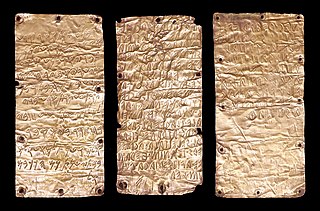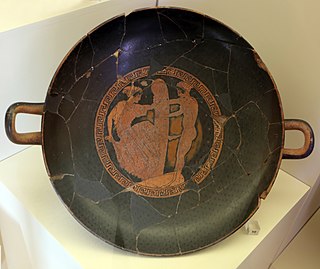
In Greek mythology, Adonis was the mortal lover of the goddesses Aphrodite and Persephone. He was famous and considered to be the ideal of male beauty in classical antiquity.
The Thesmophoria was an ancient Greek religious festival, held in honor of the goddess Demeter and her daughter Persephone. It was held annually, mostly around the time that seeds were sown in late autumn – though in some places it was associated with the harvest instead – and celebrated human and agricultural fertility. The festival was one of the most widely celebrated in the Greek world. It was restricted to adult women, and the rites practised during the festival were kept secret. The most extensive sources on the festival are a comment in a scholion on Lucian, explaining the festival, and Aristophanes' play Thesmophoriazusae, which parodies the festival.
In ancient Greek religion and mythology, Iacchus was a minor deity, of some cultic importance, particularly at Athens and Eleusis in connection with the Eleusinian mysteries, but without any significant mythology. He perhaps originated as the personification of the ritual exclamation Iacche! cried out during the Eleusinian procession from Athens to Eleusis. He was often identified with Dionysus, perhaps because of the resemblance of the names Iacchus and Bacchus, another name for Dionysus. By various accounts he was a son of Demeter, or a son of Persephone, identical with Dionysus Zagreus, or a son of Dionysus.

The Pyrgi Tablets are three golden plates inscribed with a bilingual Phoenician–Etruscan dedicatory text. They are the oldest historical source documents from Italy, predating Roman hegemony, and are rare examples of texts in these languages. They were discovered in 1964 during a series of excavations at the site of ancient Pyrgi, on the Tyrrhenian coast of Italy in Latium (Lazio). The text records the foundation of a temple and its dedication to the Phoenician goddess Astarte, who is identified with the Etruscan supreme goddess Uni in the Etruscan text. The temple's construction is attributed to Thefarie Velianas, ruler of the nearby city of Caere.
The Lenaia was an annual Athenian festival with a dramatic competition. It was one of the lesser festivals of Athens and Ionia in ancient Greece. The Lenaia took place in Athens in Gamelion, roughly corresponding to January. The festival was in honour of Dionysus Lenaios. There is also evidence the festival also took place in Delphi.

The Theatre of Dionysus is an ancient Greek theatre in Athens. It is built on the south slope of the Acropolis hill, originally part of the sanctuary of Dionysus Eleuthereus. The first orchestra terrace was constructed on the site around the mid- to late-sixth century BC, where it hosted the City Dionysia. The theatre reached its fullest extent in the fourth century BC under the epistates of Lycurgus when it would have had a capacity of up to 25,000, and was in continuous use down to the Roman period. The theatre then fell into decay in the Byzantine era and was not identified, excavated and restored to its current condition until the nineteenth century.

Arrhephoria was a feast among the Athenians, instituted in honor of Athena. The word is derived from the Greek term Ἀρρηφόρια, which is composed of ἄρρητος, "unspoken, not to be divulged", and φέρω, "I carry". This feast was also called Hersiphoria, from Herse, the daughter of Cecrops, on whose account it was established.

The Kanephoros was an honorific office given to unmarried young women in ancient Greece, which involved the privilege of leading the procession to sacrifice at festivals; the highest honour was to lead the pompe (πομπή) at the Panathenaic Festival. The role was given to a virgin selected from amongst the aristocratic or Eupatrid families of Athens whose purity and youth was thought essential to ensure a successful sacrifice. Her task was to carry a basket or kanoun (κανοῦν), which contained the offering of barley or first fruits, the sacrificial knife and fillets to decorate the bull, in procession through the city up to the altar on the acropolis.

Haloa or Alo (Ἁλῶα) was an Attic festival, celebrated principally at Eleusis, in honour of Demeter, protector of the fruits of the earth, of Dionysus, god of the grape and of wine, and Poseidon, god of the seashore vegetation. In Greek, the word hálōs (ἅλως) from which Haloa derives means “threshing-floor” or “garden.” While the general consensus is that it was a festival related to threshing—the process of loosening the edible part of cereal grain after harvest—some scholars disagree and argue that it was instead a gardening festival. Haloa focuses mainly on the “first fruits” of the harvest, partly as a grateful acknowledgement for the benefits the husbandmen received, partly as prayer that the next harvest would be plentiful. The festival was also called Thalysia or Syncomesteria.
The Oschophoria were a set of ancient Greek festival rites held in Athens during the month Pyanepsion (autumn) in honor of Dionysus, the god of the vine. The festival may have had both agricultural and initiatory functions. Amidst much singing of special songs, two young men dressed in women's clothes would bear branches with grape-clusters attached (ὠσχοί) from Dionysus to the sanctuary of Athena Skiras, and a footrace followed in which select ephebes competed. Ancient sources connect the festival and its rituals to the Athenian hero-king Theseus and specifically to his return from his Cretan adventure. According to that myth, the Cretan princess Ariadne, whom Theseus had abandoned on the island of Naxos while voyaging home, was rescued by an admiring Dionysus; thus the Oschophoria may have honored Ariadne as well. A section of the ancient calendar frieze incorporated into the Byzantine Panagia Gorgoepikoos church in Athens, corresponding to the month Pyanopsion, has been identified as an illustration of this festival's procession.
The Synoikia was an ancient Greek festival held in Athens commemorating the political unification of Attica. It was also called the Thesean Synoikismos and the Feast of Union, and celebrated Theseus as founder of Athens and the goddess Athena as the city's patron goddess. The festival was celebrated in the month of Hekatombeion on the 16th. A two-day festival, on the 15th and the 16th was held every second year.

The basilinna or basilissa, both titles meaning "queen", was a ceremonial position in the religion of ancient Athens, held by the wife of the archon basileus. The role dated to the time when Athens was ruled by kings, and their wives acted as priestesses (Hiereiai). The duties of the basilinna are described in the pseudo-Demosthenic speech Against Neaira, which is the main source of evidence about the position.

Dumuzid or Dumuzi or Tammuz, known to the Sumerians as Dumuzid the Shepherd and to the Canaanites as Adon, is an ancient Mesopotamian and Levantine deity associated with agriculture and shepherds, who was also the first and primary consort of the goddess Inanna. In Sumerian mythology, Dumuzid's sister was Geshtinanna, the goddess of agriculture, fertility, and dream interpretation. In the Sumerian King List, Dumuzid is listed as an antediluvian king of the city of Bad-tibira and also an early king of the city of Uruk.
The term gamelia (Γαμηλία) can refer to several ancient Athenian customs revolving around the act of marriage. Most often it relates to the practice in which a new husband would perform an offering in honor of his recent marriage for his phratry during the Apaturia.
The festival calendar of Classical Athens involved the staging of many festivals each year. This includes festivals held in honor of Athena, Dionysus, Apollo, Artemis, Demeter, Persephone, Hermes, and Herakles. Other Athenian festivals were based around family, citizenship, sacrifice, and women. There were at least 120 festival days each year.

The study of the lives of women in classical Athens has been a significant part of classical scholarship since the 1970s. The knowledge of Athenian women's lives comes from a variety of ancient sources. Much of it is literary evidence, primarily from tragedy, comedy, and oratory; supplemented with archaeological sources such as epigraphy and pottery. All of these sources were created by—and mostly for—men: there is no surviving ancient testimony by classical Athenian women on their own lives.
In ancient Greece, a proboulos was a magistrate on a preliminary deliberative body.

In the Roman Empire, Rosalia or Rosaria was a festival of roses celebrated on various dates, primarily in May, but scattered through mid-July. The observance is sometimes called a rosatio ("rose-adornment") or the dies rosationis, "day of rose-adornment," and could be celebrated also with violets (violatio, an adorning with violets, also dies violae or dies violationis, "day of the violet[-adornment]"). As a commemoration of the dead, the rosatio developed from the custom of placing flowers at burial sites. It was among the extensive private religious practices by means of which the Romans cared for their dead, reflecting the value placed on tradition (mos maiorum, "the way of the ancestors"), family lineage, and memorials ranging from simple inscriptions to grand public works. Several dates on the Roman calendar were set aside as public holidays or memorial days devoted to the dead.
The Pandia was an ancient state festival attested as having been held annually at Athens as early as the time of Demosthenes. Although little that is known of the Pandia is certain, it was probably a festival for Zeus, and was celebrated in the spring after the City Dionysia in the middle of the month of Elaphebolion.

Melite was a deme of ancient Attica, located in the city centre of Athens, within the walls erected by Themistocles and to the west of the Acropolis. It included the Agora and the Pnyx. It belonged to the tribe of Kekropis.












